Associate Professor Fiona Petchey is involved in several projects that provide greater chronological resolution to this question.
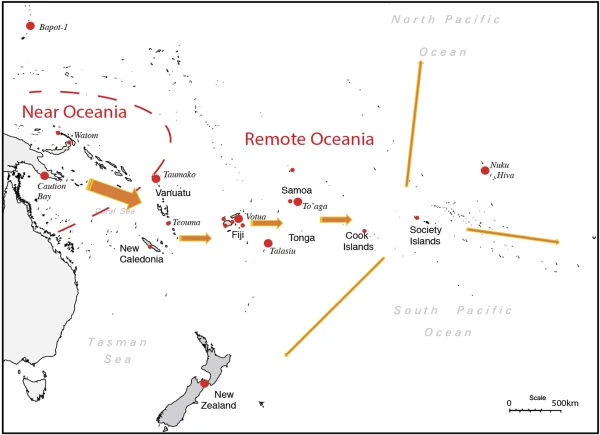
Dating the movement of people through the Pacific (red circles = Waikato 14C research areas).
Dating the first settlers of the Mariana Archipelago
When did the first explorers set off into the wide-open seas of the remote Pacific?
The date of the first settlement of the Mariana Islands remains critical to this debate, and 14C dates of shell appear to indicate settlement as early as 3500 years ago. However, 14C is not distributed evenly throughout the marine environment, and estuarine taxa are more likely to incorporate carbon from terrestrial sources, complicating the interpretation of shell 14C results. Regions where water has percolated through limestone bedrock, provide an additional problem since ancient carbon is introduced into the estuarine waters. Petchey developed a tri-isotope approach using 14C, δ13C, δ18O to identify the sources of carbon in shells. She demonstrated that some shellfish are more prone to erroneous 14C ages, including Anadara antiquata and Gafrarium pectinatum, both taxa commonly found in Pacific archaeological sites.
This 'hard water' effect explains old 3500-year-old results from Bapot-1 on the island of Saipan. Petchey's research has shifted the age of the site by 200-300 years, which brings the first movement of people into Remote Oceania into alignment with the movement of people throughout the Bismarck Archipelago.
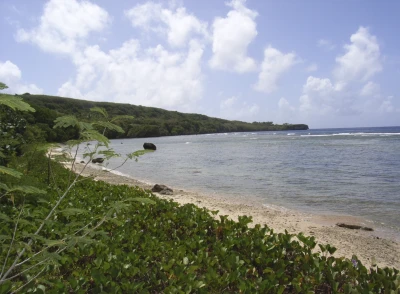
The site of Bapot-1 in Lao Lao Bay, Saipan (Photo Geoffrey Clark, ANU)
Teouma: The Lapita People
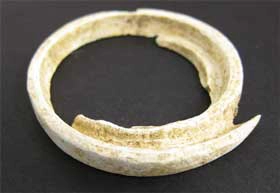
Conus arm ring (artefact), Teouma, Vanuatu (Photo Fiona Petchey)
The discovery of a Lapita cemetery at Teouma on the island of Efate in Vanuatu provided a unique opportunity to find out more about this enigmatic group of Pacific explorers. Radiocarbon dating of the Teouma site, including 36 Lapita-age burials, five dates on Conus arm rings, and dates on midden material, demonstrated that the burial ground was regularly used by 3110-2710 cal BP. Recently, researchers extracted the DNA from three of the individuals buried at Teouma. This analysis connected these individuals to burials dating between 2,680 and 2,340 years ago, from Talasiu, Tongatapu.
The Lapita/Polynesian transition; evidence from To’aga, American Sāmoa
The distribution of sites with dentate-stamped ceramic pottery maps the first human presence in Remote Oceania. This 'Lapita' culture is first recognised in the Bismarck Archipelago, possibly as early as 3350 years ago, reaching its easternmost extent in the Tongan and Sāmoan archipelagos around 2850 years ago. The timing of the first landfall on each island group by these Lapita explorers has been the subject of several chronological evaluations, but many parts of this story remain controversial. Of note are debates over the timing of the gradual loss of dentate-stamped Lapita ceramics and their replacement with undecorated ceramics (termed Polynesian Plainware). This significant change in material culture marks the beginning of Ancestral Polynesian society within a West Polynesian 'homeland'.
To’aga, on the island of Ofu, is a site that falls within this transition period. A new regional marine calibration methodology (below) has placed the first use of the site between 2785 and 2607 cal BP demonstrating that change was rapid and settlement of the Tongan and Samoan islands was far from fleeting.
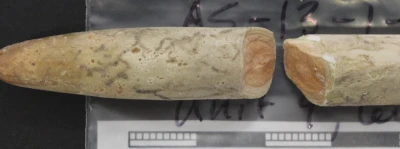
Echinoid spines from To'aga (Photo Katy Anderson)
South Pacific marine 14C
Variability in the marine 14C during the period of importance to human settlement—the last 3500 years—has been poorly studied. It is essential to rectify this so we can build robust archaeological chronologies. Published known-age marine 14C values indicate that a significant decrease in the South Pacific ΔR (the regional offset from the global marine calibration curve) occurred between 2600 and 2250 cal BP and around 600 cal BP.
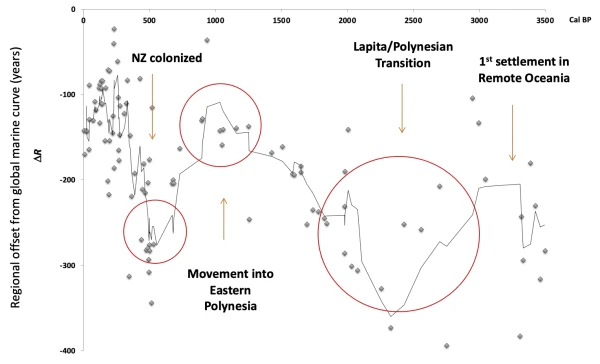
Change in ΔR across the South Pacific over the last 3500 years [Red circles = significant marine 14C offsets]. Trendline based on a 4-point moving average. Figure adapted from Petchey (2019). Note: ΔR-values have been recalculated using the Marine20 calibration dataset (Heaton et al. 2020; Radiocarbon, 62(4):779–820).
Selected publications
Petchey, F., Dabell K., Clark G., & Parton P, (2023). Evidence of temporal changes in the marine 14C reservoir in the South Pacific and implications for improved dating resolution across a radiocarbon plateau (2600-2350 cal BP). Journal of Archaeological Science, doi:10.1016/j.jas.2023.105756.
Bunbury, M.M.E., Petchey F., & Bickler S.H., (2022). A new chronology for the Māori settlement of Aotearoa (NZ) and the potential role of climate change in demographic developments. PNAS, 119(46), doi:10.1073/pnas.2207609119.
Allen, M.S., McAlister A., Petchey F., Huebert J., Maeva M., Jones B., (2021). Marquesan Ceramics, Palaeotsunami, and Megalithic Architecture: The Ho‘oumi Beach site (NHo-3) in Regional Perspective, Marquesas Islands (Polynesia). Archaeology in Oceania; doi: 10.1002/arco.5233.
Petchey, F. and Clark, G. (2021). Clarifying the age of initial settlement horizon in the Mariana Islands and the impact of hard water. A response to Carson 2020. Radiocarbon 63(3):905-913.
Petchey, F., & Schmid, M.M.E. (2020). Vital evidence: Change in the marine 14C reservoir around New Zealand (Aotearoa) and implications for the timing of Polynesian settlement. Scientific Reports, 10(1):8 pages, doi:10.1038/s41598-020-70227-3.
Petchey, F. (2019). New evidence for a mid - to late-Holocene change in the marine reservoir effect across the South Pacific Gyre. Radiocarbon, 1-13, doi:10.1017/rdc.2019.103.
Petchey, F., & Kirch, P. V. (2019). The importance of shell: Redating of the To’aga site (Ofu Island, Manu'a) and a revised chronology for the Lapita to Polynesian Plainware transition in Tonga and Sāmoa. PLOS ONE, 14(9), e0211990, doi:10.1371/journal.pone.0211990.